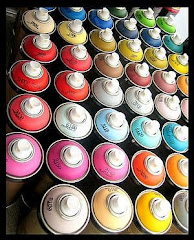
I have been seeing these cool light painting analogue shots from Lomography.com and got inspired to do some experiment using digital before going on with analogue cameras. But before we go on to the more technical stuff, I would just like to give you an overview what light painting is.
WHAT IS LIGHT PAINTING?
Light painting, also known as light drawing or light graffiti is a photographic technique in which exposures are made usually at night or in a darkened room by moving a hand-held light source or by moving the camera.
Along this tutorial, you would also encounter familiar terms such as ISO, Aperture and Shutter Speed. I am pretty certain you have already come across these technical terms before but to explain more, back in the old non-digital days, when we buy films (usually 35mm) for our cameras you will notice printed outside the box casing this --> ISO 100, 200, 400, 800; but what does it mean? A conversation between professional or even amateur photographers would also introduce you to terms such as aperture and shutter speed, but what are the importance of knowing these stuff to light painting?
WHAT IS ISO?
To clearly explain what this is, ISO as it relates to photography is a measure of how sensitive the capture array is to light. The higher the ISO, the more sensitive it is to light. ISO 100/200 are usually used to bright lit conditions such as sunny days or if you are using studio lights. ISO 800 for poorly lit conditions, ISO 400 for general purpose.
WHAT IS APERTURE?
An aperture is a hole or an opening through which light travels. More specifically, the aperture of an optical system is the opening that determines the cone angle of a bundle of rays that come to a focus in the image plane. Generally, aperture and shutter speed are inversely related. Meaning if one goes up, you have to compensate by reducing the other one to properly expose the picture.
WHAT IS SHUTTER SPEED?
I'm pretty sure you all know what shutter speed is. :)
GATHERING MATERIALS
1) Choosing the right camera to do the job. In my experiment, I used GE X500 DSLR for my light painting. This is a pretty affordable model of DSLR camera and it's good for beginners too especially those who would want to experience the capabilities of DSLR cameras. However, if you do not have a DSLR you can always use your point-and-shoot camera. All you need to do is search for the correct setting (usually the fireworks mode) and you're on with it. You no longer need to worry about the technical part like setting up the ISO, aperture and shutter speed but then again, doing extensive and detailed light painting would be impossible with point-and-shoot cameras because most point-and-shoot cameras does not have the manual set-up of shutter speed.


2) You need the camera to be steady. What better way to do this with a tripod of course unless you have ultra steady hands. However, if you do not have any tripod you can always use any inanimate objects like your table or your bed to set your camera.

3) You need torches! Of course you cannot do light painting without light so you need any possible light source you have at home. In my case, I used all the flashlights I could see scattered around my room.

4) Colored Cellophane, Scissors and Duct Tape. Although these are optional, I wrapped my torches with colored cellophane to achieve a colorful light painting.



What do I need to do?
FOR DSLR CAMERAS:
1) Mount your camera to your tripod.

2) Choose the Manual Set-up Mode.

3) Set-up the aperture. Small aperture for brighter background / large aperture for dimmer background.

4) Set-up the shutter speed. Put the shutter speed to slowest as possible like you are trying to capture fireworks.

5) ISO should stay the lowest otherwise your light would be too bright which will ruin your painting.
3) Set-up the timer.
4) Turn your torches on and start painting.
FOR POINT-AND-SHOOT CAMERAS:
1) Mount your camera to your tripod.
2) Choose the Scene Set-up Mode and select Fireworks.

3) Set-up the timer.
4) Turn your torches on and start painting.
Light Painting
Start your light painting as soon as the timer sets-off. I made mine completely in the dark, however you can do it with ample light like at dusk or in a dimly lit room just as long as the light coming from your torches is bright but you may need to adjust the ISO, Aperture and Shutter Speed of your camera if this is the case.

You also have to remember that you need to write backwards if you're doing text. Remember that you're writing in "front" of the camera.
SAMPLE OUTPUT
Did everything with my younger brother.















1 comment:
By the way... since I've posted a comment on an older post, I took the time to see a bit of your blog and found it very nice. This light painting post is very beautiful and well explained. I had never heard of it before. Thanks. You're a genuine artist!
Post a Comment